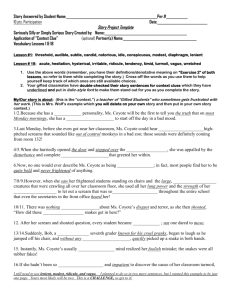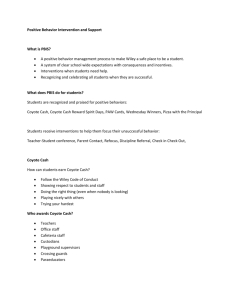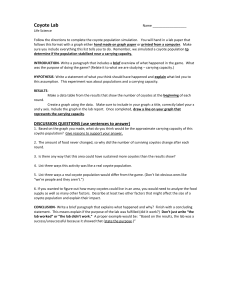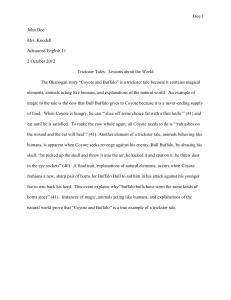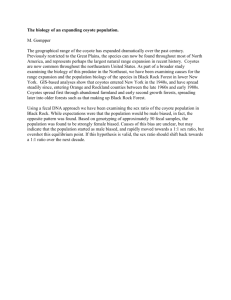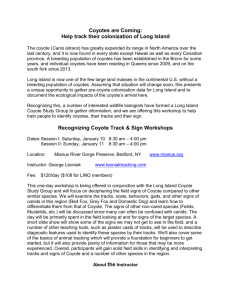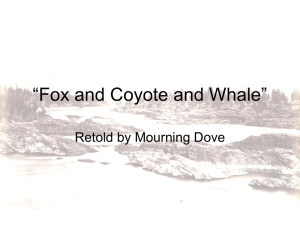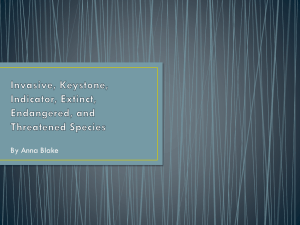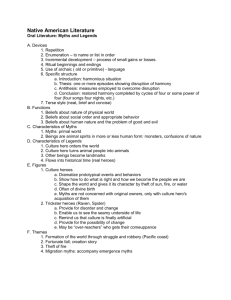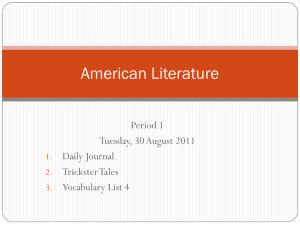Understanding Coyote Stories - Arlee Joint School District No. 8
advertisement
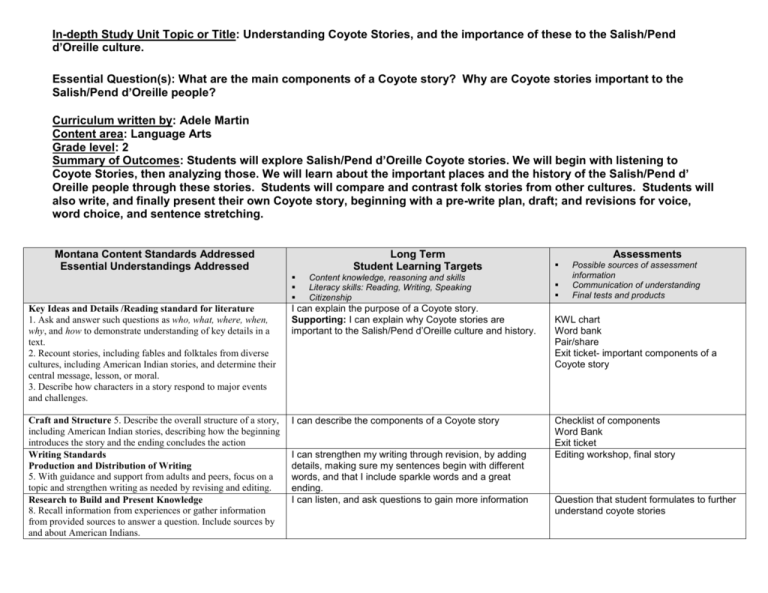
In-depth Study Unit Topic or Title: Understanding Coyote Stories, and the importance of these to the Salish/Pend d’Oreille culture. Essential Question(s): What are the main components of a Coyote story? Why are Coyote stories important to the Salish/Pend d’Oreille people? Curriculum written by: Adele Martin Content area: Language Arts Grade level: 2 Summary of Outcomes: Students will explore Salish/Pend d’Oreille Coyote stories. We will begin with listening to Coyote Stories, then analyzing those. We will learn about the important places and the history of the Salish/Pend d’ Oreille people through these stories. Students will compare and contrast folk stories from other cultures. Students will also write, and finally present their own Coyote story, beginning with a pre-write plan, draft; and revisions for voice, word choice, and sentence stretching. Montana Content Standards Addressed Essential Understandings Addressed Long Term Student Learning Targets Content knowledge, reasoning and skills Literacy skills: Reading, Writing, Speaking Citizenship Key Ideas and Details /Reading standard for literature 1. Ask and answer such questions as who, what, where, when, why, and how to demonstrate understanding of key details in a text. 2. Recount stories, including fables and folktales from diverse cultures, including American Indian stories, and determine their central message, lesson, or moral. 3. Describe how characters in a story respond to major events and challenges. I can explain the purpose of a Coyote story. Supporting: I can explain why Coyote stories are important to the Salish/Pend d’Oreille culture and history. Craft and Structure 5. Describe the overall structure of a story, including American Indian stories, describing how the beginning introduces the story and the ending concludes the action Writing Standards Production and Distribution of Writing 5. With guidance and support from adults and peers, focus on a topic and strengthen writing as needed by revising and editing. Research to Build and Present Knowledge 8. Recall information from experiences or gather information from provided sources to answer a question. Include sources by and about American Indians. I can describe the components of a Coyote story I can strengthen my writing through revision, by adding details, making sure my sentences begin with different words, and that I include sparkle words and a great ending. I can listen, and ask questions to gain more information Assessments Possible sources of assessment information Communication of understanding Final tests and products KWL chart Word bank Pair/share Exit ticket- important components of a Coyote story Checklist of components Word Bank Exit ticket Editing workshop, final story Question that student formulates to further understand coyote stories Speaking and Listening Standards3. Ask and answer questions about what a speaker says in order to clarify comprehension, gather additional information, or deepen understanding of a topic or issue. I can listen, and ask questions to gain more information Participation in guest speaker discussion Essential Understanding 1 I can map Coyote story locations. Map of western Montana that includes Coyote story places marked I can explain the purpose of a Coyote story. Checklist of components of a Coyote story Exit ticket I can tell when it is time to tell Coyote stories. There is great diversity among the 12 tribal Nations of Montana in their languages, cultures, histories and governments. Each Nation has a distinct and unique cultural heritage that contributes to modern Montana. Essential Understanding 3 The ideologies of Native traditional beliefs and spirituality persist into modern day life as tribal cultures, traditions, and languages are still practiced by many American Indian people and are incorporated into how tribes govern and manage their affairs. Additionally, each tribe has its own oral histories, which are as valid as written histories. These histories pre-date the “discovery” of North America. Sequence of scaffolding lessons What sequence of steps will best engage, support and hold students accountable to reaching the above learning targets? What student and teacher involved assessment for learning strategies and routines can you build in? What instructional practices and protocols will you use? Instructional Practices selected: 1. Introduce the essential question. Lead into Lesson 1 Students listen to a basic explanation of what a Coyote story is, and why they are important. Teacher posts important components on board. Students listen to the teacher read, “Coyote and the Mean Mountain Sheep” Students help construct a KWL chart, and a start the word bank 2. I know when it is time for Coyote stories Students listen to background information about the correct season to tell Coyote stories. Students listen to the teacher read “Winter of Long Ago”, from the Nkwusm language school. Create a word bank of related words to use next. Students make a season’s picture with emphasis on winter activities, then add word bank to describe picture. Add to KWL chart. Exit ticket: I know when it is time for Coyote stories, indicate season and why 3. I know what is in a Coyote story Gather students; tell them it is time to listen to a Coyote story. Read a selected story. Discuss the components of a Coyote story. Write these on the board. Hand out a checklist of the components, so the students can read them and check them off as you read a second story. As a group discuss the checklist, and check off what applies. Add the checklist words to the word bank, and information to the KWL Inquiry W of KWL chart Question formulation for guest speaker Comprehension KWL chart Coyote stories students author Editing workshop Vocabulary Development Word bank KWL Venn-diagram Oral Participation Protocols Pair share Guest speaker questions/discussion Reading of finished story 4. I can map with Coyote Gather students; show map of Western Montana, and Idaho. Refer to “Coyote and Mean Mountain Sheep”, discuss where that occurred. Show on map where the Medicine Tree is, near Darby, Mt. Mark spot. Hand out maps to all students. Locate Darby, and mark the spot of the Medicine tree on their maps. Tell the story of how Coyote lost the salmon on Lolo Pass, and how Coyote brought wild plums to Dixon. Mark these areas on their maps as well. Update word wall and KWL Tell students that we will have a guest speaker to tell a coyote story, and they need to think of a question to ask that will help them to understand these stories, and to write their own. 5. Guest speaker day Arrange for an elder to tell a Coyote story to your class. Make the elder feel welcome, and comfortable. Allow time for a good story, and question time Students will ask their question that they made at the end of mapping lesson 6. I can compare/contrast a Coyote story with an Anansi story Have students listen as you read your Coyote story. Write setting, character, plot on the chart, have students I.D. for Coyote story. Read the Anansi story, and have students do the same for that. Fill in Venn-diagram for same/different Hand out 3-pg. mini-booklet, pg. 1 for Coyote, listing 1-2 important things and a drawing. Second pg. for Anansi, 3rd pg one or two alike and different for both. Go back to L.T. If students agree that we compared/contrasted Coyote and Anansi, place a smiley face next to the L.T. Do the same for second L.T., I can find what is the same, and what is different about Coyote, and Anansi. 7. I can write a Coyote story Ideas: First have students think of the idea for their story. As they think, encourage them to draw a picture of what they want to write about. Go over the components of a Coyote story that were in the checklist in lesson 2. Have students get out their checklist, so they can use as guide. Get everyone writing. Keep referring to the checklist, make sure everyone is including at least 2 components. This may take more than one class time. 8. I can edit and revise to strengthen my Coyote story. When stories are ready, post editing checklist,(this lesson will focus on one trait, and will need to be followed with at least 2 more editing sessions so details, sentence variety, word choice, and organization are addressed.) Guide this process, teacher being the final editor When finished, type stories for students Add art from lesson 6 to present with story Represent-to-Learn Map Art presentation Draw to write Write-to-learn Admit/exit tickets Questions for guest speaker Finished Coyote story 9. Preparation for presentation Pair students, and have them practice reading their story to each other. When they feel ready, have them take turns reading their story to the class. Write invitations to other classrooms for presentation day 10. Finish word bank and KWL Add anymore words to the word bank that students feel should be included. Add anything you think was missed. Tell students that when we present stories, we will read our word bank, and share our KWL chart Finish KWL chart, add what we have learned. 11. Student presentations Students will read our word bank to classes, and share KWL chart. Students will take turns reading their stories to classes, and explain about why Coyote stories are important to the Salish/Pend d’Oreille people. Our stories and art will be posted in the school for all to enjoy, during the season of storytelling. Resources: (e.g. Anchor Texts, District adopted materials, Supplementary resources, Web-sites) Nenemay, Jesse. 2012. Winter of Long Ago, Administration for Native Americans ANA. Nkwusm Salish Language Revitalization Institute Salish Cultural Committee of the Confederated Salish and Kootenai Tribes. Coyote and the Mean Mountain Sheep. The Indian ReadingSeries: Stories and Legends of the Northwest Salish Cultural Committee of the Confederated Salish and Kootenai Tribes. Salish/Pend D’Oreille Coyote Stories. St.Ignatius, Mt. Nkwusm Salish Language Revitalization Institute, Salish Cultural Committee, Resources for Coyote stories, elders to tell stories, information about Coyote story locations for mapping Ruth Culham. “6+1 Traits of Writing”. 2005. Scholastic Inc. “Maps of Montana” www.montana-map.org Anansi stories http://africa.mrdonn.org and http://www.real-jamica-vacations.com
